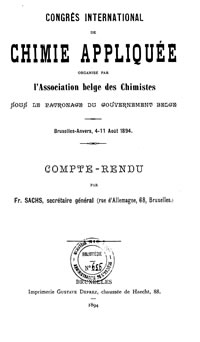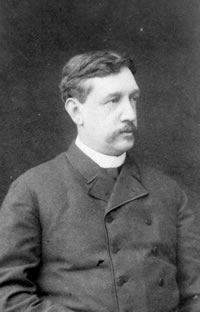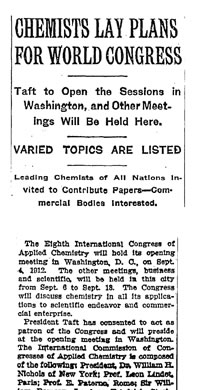|
|
Vol.
33 No. 4
July-August 2011
by D. Thorburn Burns and H. Deelstra
The first in the series of international congresses of chemistry was held 3–5 September 1860 in Karlsruhe, Germany. This conference—called to discuss chemical nomenclature, notation, and atomic weights—was the idea of August Kekulé (1829–1896) and came to reality with the assistance of Adolphe Wurtz (1817–1884) and Carl Weltzien (1813–1870).*
After the Karlsruhe meeting, the international conventions of chemists were associated with the discussions of exhibits at the various International Expositions at Paris (1867, 1878, and 1889), Moscow (1872), Vienna (1873), Philadelphia (1876), Düsseldorf (1880), Milan (1881) and Chicago (1893). They had no formal organization relating one to the other or in sequencing.
 |
| Title page of the Proceedings of the First International Congress of Applied Chemistry. |
The Paris Congress of 1889 was opened by Marcelin Berthelot (1827–1907) whose stated concept that “Theories are not to be considered, but only practical questions, such as those related to analytical methods and nomenclature . . . ” carried over to the 1893 congress held in conjunction with the World’s Columbian Exposition in Chicago. At this congress, the chairman, Harvey Washington Wiley (1844–1930) suggested the establishment of a triennial international congress of chemistry. The American Chemical Society, which had met at the congress, set up a committee to consider “the expediency of holding similar congresses at regular recurrent intervals of time,” and, subsequently, issued a letter of invitation in 1894 to foreign chemical societies to appoint similar committees.1 However, prior to the drafting of the ACS letter, this concept was independently conceived by and acted upon by the Association of Belgian Chemists, which in 1891 proposed an international congress for 1893; however, the meeting was postponed until 1894.2–4
Thus, the International Congresses of Applied Chemistry did not, as previously suggested by George Sarton (1884–1956) in his Guide to the History of Science (1952)5 succeed the International Chemical Congresses, but developed from the community need. The Applied Chemistry Congresses had a considerable influence on the rates and degrees of professionalization of chemists in the various host countries. The two types of congresses continued their independent and separate ways, as exemplified by Paris acting as host for the two types of congresses in 1900: the Congrès International de Chimie Pure, organized in conjunction with the Universal Exhibition, was not well supported, while the Congrès International de Chimie Appliquée was more successful and generated much published material.
The First International Congress on Applied Chemistry, held 4–11 August 1894 in Brussels and Antwerp, was organized by the Association of Belgian Chemists. This important initiative was undertaken by a very young association, having been founded in 1887.
Edouard Hanuise (1842–1913),6 the first president of the association, announced at the General Assembly on 29 April 1891 that the board of management had discussed the possibility of organizing an International Congress in Brussels. The idea had been put forth by François Sachs (1849–1919),7 the association secretary, and Hanuise, both of whom were members of the sugar section and had good relations with sugar chemists in the European sugar-producing countries.
Sachs got the idea at the annual conference of the Austrian-Hungarian sugar chemists in 1890 when their chairman, Friedrich Strohmer (director of the Experimental Station for the Beet-Sugar Industry, Vienna) said it would be useful to organize an international meeting for all sugar chemists to unify the analytical methods used in the industry. At first, Hanuise and Sachs thought to restrict the scope of the proposed conference in Brussels to sugar and agricultural chemistry. However, D. Van Bastelaer (1823–1907), chairman of the food section, opposed this idea and convinced the association that the conference should be organized by the association alone, and should contain four sections, namely sugar, agricultural, food, and biological chemistry.
Sachs was the main driving force in the organization of this first congress. He came to an agreement with the French Sugar Association that the first congress should be in Brussels in 1892 and the second in Paris. He then encouraged all members of the association’s four sections to prepare for the event. Because time was short, the Congress was postponed until 1893. On 29 August 1892, the first circular of the Congrès International des Chimistes to be held in April 1893 was sent out, together with an attachment of 29 topics.
Finally, the conference was held in 1894 in Brussels and Antwerp, because that year an International Exhibition was in Antwerp. Due to the International Exhibition it was easier to attract subsidies and convince chemists from abroad to assist as well as to attend. The title became Congrès International de Chimie Appliquée and was confined to chemical aspects of sugar refining, agricultural chemistry, foodstuffs, and biological chemistry. For most of the topics, position papers were prepared. The conference proved to be very successful, attracting 397 participants from 27 countries. At the closing session, the conclusions of all the questions considered were discussed. Most of the resolutions were accepted, with some partially accepted and adjourned to the next conference (e.g., control of food falsification, the effects of discharge of treated and untreated water into rivers). For some questions, international committees were set up to prepare reports for the next congress (e.g., calibration of chemical instruments, assimilation of phosphates by plants in different types of soil). Finally, it was decided that the second congress on applied chemistry would be held in 1896 in Paris.
François Sachs was the main driving force
in the organization
of this first congress. |
The Second International Congress on Applied Chemistry was organized by the Association of Chemists of the Sugar and Distillery Industries of France and the Colonies and held in Paris, 27 July to 8 August 1896. Léon Lindet (1857–1927) was chairman and François Dupont (1841–1911) secretary general of the organizing committee. Both were members of the French Sugar Association. The conference was placed under the patronage of the French government and chaired by Pierre Eugène Marcelin Berthelot (1823–1907), the permanent secretary of the French Academy of Sciences and honorary chairman of the Sorbonne.
The main aims of the congress were to unify analytical methods, produce an agreement to stop the falsification of foods and agree upon procedures for dealing with waste waters from cities and industries.
The areas of applied chemistry were at first extended to nine sections. In addition to the four in the first conference, sections were added on calibration of precision instruments, chemical industries, photography, electrochemistry, mining, and metallurgical industries. Just before the start of the congress, an eleventh section was added on waste-water treatment. This second congress attracted 1500 participants. The 500 or so questions introduced were discussed in the 60 sessions.
The opening address by M. Berthelot was noteworthy; first he made it clear that the congress was focussed on applied chemistry. He said, “You, [messieurs] gentlemen, you are the specialists in the applied chemistry.” He stressed, however, that “pure chemistry is an essential base for applied chemistry” and went on to say “in chemistry, theory and practice are bound to each other by indissoluble ties.”
The proceedings of the congress made up five volumes, each of about 500 pages. The agreed resolutions are clear links to the first conference at which several international committees were created to prepare reports on clearly specified topics in order to continue or to finalize the debates at the next conference. In the analytical section, specific committees were established in order to make proposals on the calibration of different instruments (e.g.,“the saccharimetric scale”).
The third congress was held in Vienna, 28 July to 2 August 1898. The secretary general of the organizing committee was F. Strohmer. The congress was divided into 10 sections, with a new section on the teaching of applied chemistry and professional affairs. The aims of the congress were as before: discussions of important problems in applied chemistry, unification of methods of analysis, and the teaching of applied chemistry. For this meeting, all the chemical laboratories in Vienna were opened to
delegates.
 |
| Edouard Hanuise (1842–1913), first president of the Association of Belgian Chemists. |
The fourth congress was held, once again, in Paris, from 23 to 31 July 1900. The congress was attended by more than 1800 delegates and the program was very similar to that of the 1896 meeting. During the congress, two important permanent commissions were established. The first was tasked with the realization of the resolutions agreed at each congress and was made up of the presidents of each congress. The second was to deal with analytical matters. This commission, under the presidency of Dr. G.F. Lunge (1839–1923) of Zurich, contained at least two experts from each country. Their task was to prepare documents about the conclusions from each congress and present the consensus views at the next congress.
The fifth congress was held in Berlin, 2–8 June 1903. In the invitation to attend it was made clear that the Berlin Congress would be organized just as the previous congresses. The number of attendees climbed to 2533 chemists from 38 different countries. About 500 papers were presented over 11 sections. An innovation was the introduction of plenary lectures.
| The eighth congress, held in 1912 in Washington and New York, 4–13 September, attracted nearly 4500 participants . |
The sixth congress was in Rome, 26 April to 3 May 1906. The invitation to attend noted that the first conference in this series was in Brussels in 1894 but incorrectly stated that it was at the initiative of the Belgian Association of Sugar Chemists. The conference was divided into 11 sections, 658 papers were presented and the total attendance was 2375. The excellent performance of the International Committee on Analyses, established at the Paris Congress of 1900, is demonstrated by the lengthy report presented. The organization of this congress was very complex due to the structure of chemistry in Italy at the time; its success was a major step toward the professionalization of chemistry in Italy.
The seventh congress took place in London from 27 May to 2 June 1909. The attendance was 4100, 958 papers were presented in 11 sections and 6 subsections, and the proceedings ran to 18 volumes. As in 1906, the International Committee on Analyses produced its report for the congress. The report by the Explosives Section on The Rise and Progress of the British Explosives Industry presaged the times to come and the demise of the series.
Each congress became larger than the one before. The eighth congress, held in 1912 in Washington and New York, 4–13 September, attracted nearly 4500 participants with subjects for discussion divided into 23 sections. The proceedings filled 29 volumes. The next congress was planned for 1915 in St. Petersburg, Russia, but World War I intervened. The extensive report by the International Committee on Analysis was again given by Lindet. In addition to the lectures and social program, an extensive tour of various industries was provided. The eighth congress was regarded at the time as a great success with “the most brilliant assemblage of men eminent in pure and applied chemistry ever brought together on this continent and a worthy successor of the preceding congresses.”
 |
| . .On 6 March 1911, 18 months prior to the 8th Congress in Washington, D.C., The New York Times published this article, which undoubtedly helped spur interest in the event. |
Despite the praise, after due reflection and discussions with friends, Bernard Conrad Hesse (1869–1934) gave a critique of the eighth congress and aspects of the seventh, with the aim of assisting the organizers of the ninth congress planned for 1915 in St. Petersburg. Interestingly, the Belgian Association of Chemists had expressed similar criticisms after the fourth congress in Paris, 1900.
The aftermath: As noted, the ninth congress, planned for 1915 in St. Petersburg did not take place. After the founding of IUPAC, the initiative for planning congresses became its responsibility. However, due to political and financial constraints, the International Congresses of Pure and Applied Chemistry did not commence until 1934. The loss of the International Congresses of Applied Chemistry was noted in 1927 and IUPAC was criticized for its 15-year delay and lack of action “in bringing the chemists of the world together in a congress organized along democratic lines and devoted to science.” The spirit of the Congresses of Applied Chemistry re-emerged in the series of EUROANALYSIS Conferences, starting in 1972 at Heidelberg.8 The sixteenth in this series will be in Belgrade, 11–15 September 2011, in this the International Year of Chemistry.
Note
The expanded and fully referenced version of this article is available at Microchimica Acta 2011, Volume 172, Numbers 3–4, Pages 277–283; doi: 10.1007/s00604-010-0465-3
- F.W. Clarke, C.E. Munroe, H. Carrington Bolton, E. Hart, W.O. Atwater. “Letter to Foreign Chemical Societies.” Science, 1894, 16, 880–881
- H. Deelstra, R. Fuks. “La Belgique organise en 1894 le premier congrès international de chimie appliquée.” Chim. Nouv., 1995, 13, 1443–1447.
- D.T. Burns, H. Deelstra. “Analytical Chemistry in Belgium: An Historical Overview.” Microchim. Acta, 2008, 161, 41–66.
- D.T. Burns, H. Deelstra. “Some Aspects of the Rise of Analytical Chemistry in Belgium.” Anal. Bioanal. Chem., 2008, 391, 1113–1117.
- G. Sarton. A Guide to the History of Science: A First Guide for the History of Science: With Introductory Essays on Science and Tradition. Chronica Botanica Co., Waltham, Mass., USA, 1952; pp. 290–302.
- H. Deelstra, B. Van Tiggelen. “Edouard Hanuise: Président-Fondateur de l’Association des Chimistes en Belgique.” Chim. Nouv., 2003, 22, 21–23.
- H. Deelstra, M. Péters. “Les deux Premiers Secrétaires Généraux de la Société Chimique de Belgique.” Chim. Nouv., 2009, 27, 11–15.
- D.T. Burns, A. Gogola, H. Malissa, L. Niinistö. 25 Years of the Working Party on Analytical Chemistry of the Federation of European Chemical Societies. Slovenian Chemical Society, Ljubljana, 1999.
D.T. Burns <[email protected]> is with the School of Chemistry and Chemical Engineering, The Queen’s University of Belfast, Belfast, Northern Ireland, UK. H. Deelstra <[email protected]> is with the Campus Drie Eiken, University of Antwerp, Belgium.
Page
last modified 27 June 2011.
Copyright © 2003-2011 International Union of Pure and Applied Chemistry.
Questions regarding the website, please contact [email protected] |